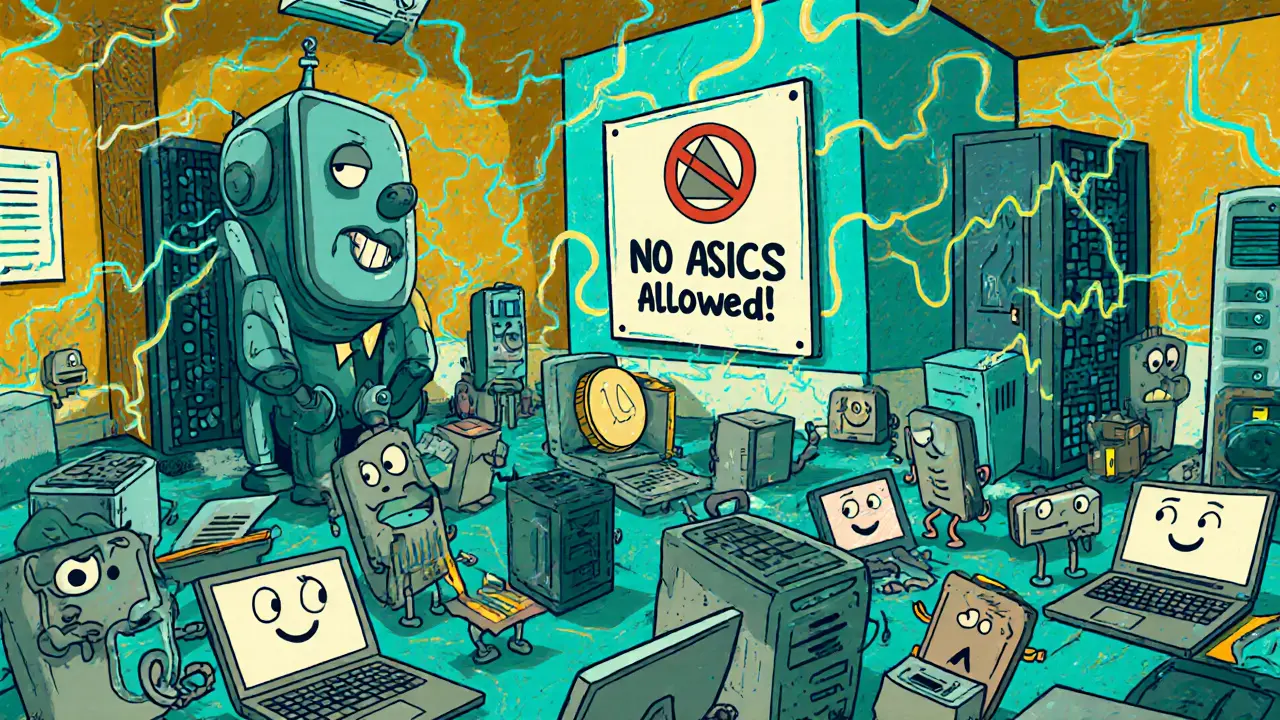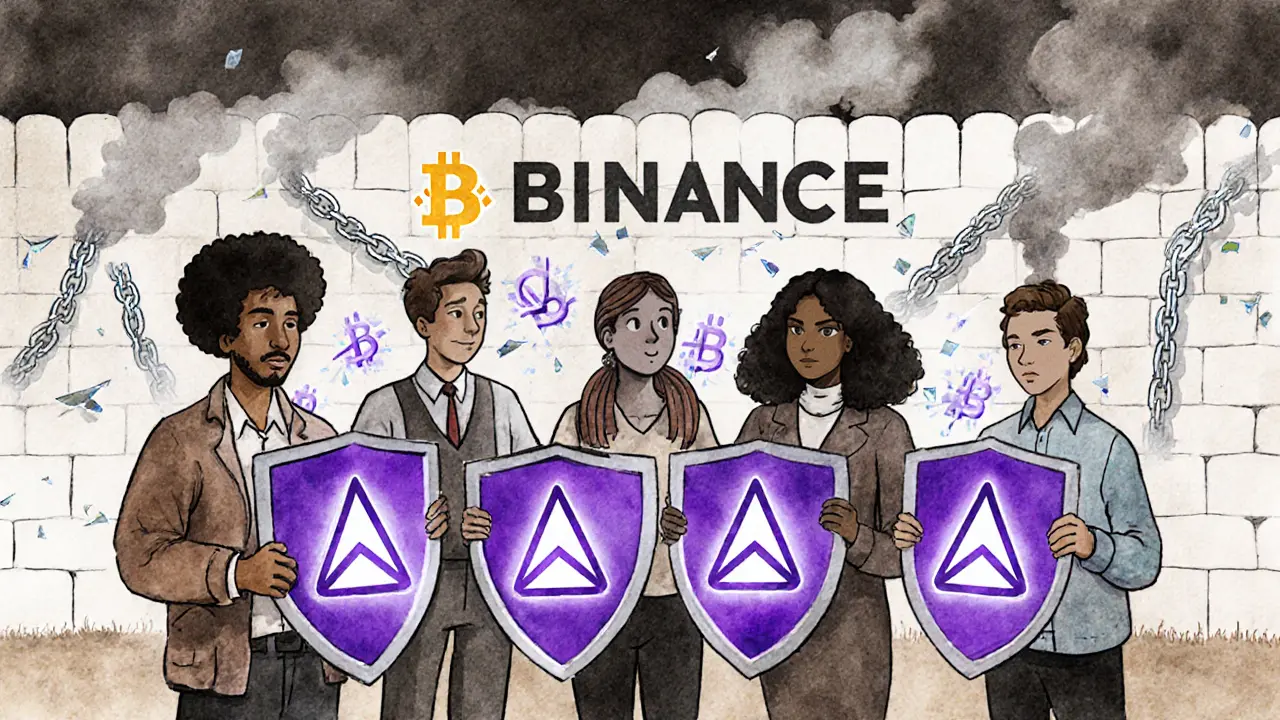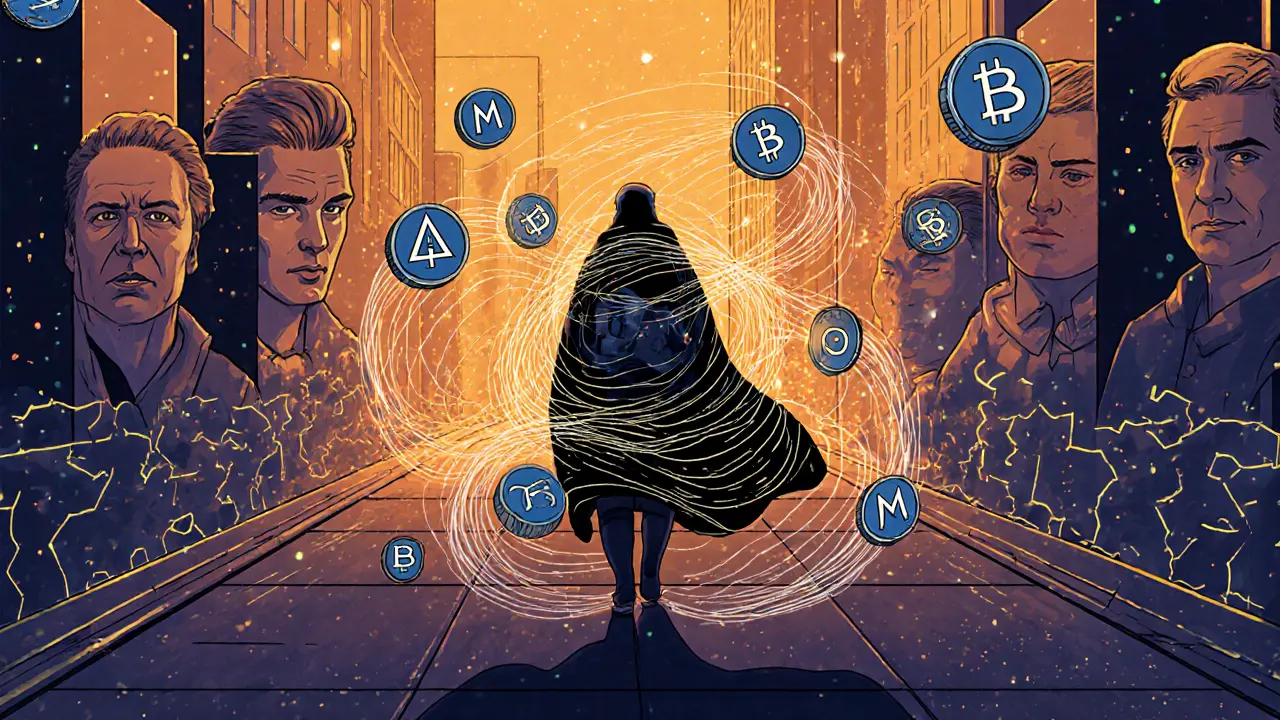Monero Privacy Calculator
How Monero's Privacy Works
Monero uses ring signatures to mix your transaction with decoy transactions, making it impossible to determine which one is yours. The larger the ring size, the stronger the privacy.
Why this matters: With a ring size of 11, an attacker would need to analyze 11 transactions to identify yours. At ring size 64 (future upgrade), this increases to 64 possible transactions.
Most cryptocurrencies leave a public trail. Every transaction, every sender, every receiver - all visible for anyone to see. Bitcoin, Ethereum, even the so-called "privacy coins" like Zcash - they all expose something. But Monero doesn’t. Not by default. Not ever. If you want real financial privacy in the digital world, Monero (XMR) is the only cryptocurrency that delivers it without asking you to turn it on.
How Monero hides everything - by default
Monero isn’t just another crypto. It was built from the ground up to make transactions untraceable. While other coins offer optional privacy features, Monero makes privacy mandatory. Every single transaction is hidden using three powerful technologies working together: ring signatures, stealth addresses, and Ring Confidential Transactions (RingCT).
Ring signatures mix your transaction with at least 10 others, making it impossible to tell which one is yours. Think of it like walking into a room with 10 people who all look like you - now someone tries to figure out who took the coffee. You can’t. That’s ring signatures in action. Since the October 2022 upgrade, Monero uses ring sizes of 11, meaning your transaction is hidden among 10 decoys.
Stealth addresses solve the problem of public wallet addresses. Instead of sending money to your permanent address, the system generates a one-time, unique address for each payment. Even if someone watches your wallet, they can’t see incoming funds. No one can link your transactions to your identity - not even if they have your public key.
RingCT, added in 2017, hides the amount. In Bitcoin, you can see that someone sent 5 BTC. In Monero, you only know that a transaction happened - not how much. This stops anyone from tracking spending habits, income levels, or business transactions.
Why Monero is different from Zcash, Dash, or Verge
Zcash is often called a privacy coin, but here’s the catch: only 2.4% of its transactions use the private shielded feature. Most users stick with transparent addresses because they’re easier. That’s not privacy - that’s optional obscurity.
Dash’s PrivateSend used to look promising, but academic studies from University College London in 2020 proved it could be deanonymized with 99% accuracy. Verge? Its network barely processes 0.3 transactions per second and has known security flaws. Monero doesn’t have these loopholes. It doesn’t rely on user choice. It doesn’t have weak spots. Every transaction is private - no exceptions.
This is why Monero is the only major crypto where anonymity is built into the protocol. The Monero Project says it plainly: "Every user is anonymous by default." No other coin can make that claim and back it up with real, tested cryptography.
How Monero mining works - and why it matters
Monero doesn’t use ASICs. That’s intentional. ASICs are specialized mining chips that give big companies an unfair advantage. They centralize mining power, which breaks decentralization.
Monero uses RandomX, a proof-of-work algorithm designed to run best on regular CPUs - the kind in your laptop or desktop. Even smartphones can mine Monero. This keeps mining open to everyday people. You don’t need to buy expensive hardware. You don’t need to join a mining pool just to have a shot. As of 2023, over 90% of Monero mining is done on consumer-grade hardware.
RandomX was introduced in late 2019 to replace CryptoNightR. It’s been updated since to stay ahead of hardware trends. The goal? Keep mining fair. Keep the network decentralized. And so far, it’s working.

Supply and economics - no hard cap, but a steady flow
Monero doesn’t have a fixed supply like Bitcoin’s 21 million. Instead, it has a tail emission. After May 2028, when the initial 18.132 million XMR are mined, the network will continue to reward miners with 0.6 XMR per minute - forever.
This isn’t inflationary chaos. It’s a smart design. It ensures miners always have an incentive to secure the network, even if transaction fees drop. No hard cap means no risk of miners abandoning the chain. It’s a long-term security model that prioritizes sustainability over scarcity.
As of October 2023, Monero’s market cap sits around $1.845 billion, with each XMR trading near $155. It’s ranked 28th by market cap - not the biggest, but the most private. And in a world where surveillance is growing, privacy has value.
Why regulators hate Monero
Monero is the most targeted cryptocurrency by governments and law enforcement. The U.S. IRS offered $625,000 in contracts in 2020 to blockchain analysis firms like Chainalysis - just to try and trace Monero. In 2022, Binance delisted Monero from Canadian exchanges due to regulatory pressure. Japan banned its use entirely in 2020. South Korea followed with restrictions in 2021.
Why? Because Monero works. It makes financial surveillance impossible. The Financial Action Task Force (FATF) and Europol have both flagged privacy coins as high-risk. A 2023 Europol report claimed Monero made up 87% of darknet market crypto - a number Monero’s community disputes, pointing out that Bitcoin still dominates illicit transactions by volume.
But here’s the real issue: Monero isn’t just used for crime. Journalists in Belarus used it to receive payments without government tracking. Activists in Iran and Turkey turned to Monero after their local exchanges were shut down. Small businesses use it to protect supplier contracts from competitors. Monero isn’t a criminal tool - it’s a human right tool.

Using Monero today - easier than you think
Back in 2016, using Monero meant typing commands in a terminal. Today? The official Monero GUI wallet (version 0.18.1.2 as of October 2023) is simple. You download it, open it, create a wallet - and you’re done. Most new users can send their first transaction within two hours, according to community surveys.
You still need to understand a few things: your view key lets someone see incoming transactions without letting them spend. Your spend key is your password to send money. Keep it safe. Never share it. But unlike Bitcoin, you don’t need to worry about address reuse or transaction history.
There are over 23 merchant services that accept Monero. You can use it on Shopify via CoinPayments, on WooCommerce with the Monero plugin, or even directly through hardware wallets like Ledger (with third-party apps). It’s not everywhere - but it’s growing.
Challenges and trade-offs
Monero isn’t perfect. Transaction fees are higher than Zcash - around $0.04 per transaction. That’s cheap compared to Bitcoin’s $1.20, but it’s still more than some privacy alternatives. Transaction speed is slower too: 2 minutes per block, 10 confirmations for full security. That’s about 20 minutes to be 99% sure a payment went through.
Syncing the full blockchain takes 3-5 hours on a fast SSD. That’s why most users use lightweight wallets or remote nodes. It’s not ideal, but it’s a trade-off for privacy.
And while Monero’s community is strong - 573 developers on GitHub, 156,000 members on r/Monero - the learning curve still scares beginners. CryptoSlate’s 2023 survey found only 42% of users rated Monero’s user experience as "good." But that’s changing. Every new wallet update makes it simpler.
The future of Monero
The next major upgrade, "Wolfram Wolff," is scheduled for October 2024. It introduces Triptych - a new ring signature system that increases ring sizes to 64 while cutting computational load by 80%. That means faster, smaller, and even more private transactions.
Other projects like Kovri (an I2P router to hide your IP) and Fluffy Blocks (to reduce bandwidth usage) are in active development. The Monero Community Fund has allocated $1.2 million in 2023 to support 37 development projects.
Will Monero survive regulatory crackdowns? Analysts are split. Some say it’ll fade. Others, like core developer Sarang Noether, argue that as surveillance capitalism grows, demand for true privacy will explode. Countries like Switzerland already accept Monero for municipal payments. Iran and Turkey saw a 200% spike in Monero searches after exchange bans.
Privacy isn’t a feature. It’s a necessity. And Monero is the only cryptocurrency that treats it that way.
Is Monero really untraceable?
Yes, as of current technology, Monero transactions are untraceable. Ring signatures, stealth addresses, and RingCT work together to hide sender, receiver, and amount. No blockchain analysis firm has proven otherwise under real-world conditions. Claims of partial tracing (like CipherTrace’s 44%) have been debunked by Monero’s research team. The system is designed so that even with massive computing power, tracing is computationally infeasible.
Can I buy Monero on Coinbase or Binance?
Not directly on Coinbase. Binance still lists Monero in most regions, but delisted it in Canada and some EU countries due to regulatory pressure. Your best options are exchanges like Kraken, KuCoin, or local peer-to-peer platforms like LocalMonero. Always check your country’s regulations before buying.
Is Monero legal?
Monero is legal in most countries, but some have restricted its use on exchanges. Japan banned it outright in 2020. South Korea and Canada have imposed limits. In the U.S., owning or trading Monero is not illegal, but the IRS treats it as property and tracks it for tax purposes. Always check your local laws before using it.
How do I store Monero safely?
Use the official Monero GUI wallet or CLI wallet. For maximum security, store your wallet on an offline computer (air-gapped). Never share your spend key. Back up your 25-word seed phrase - it’s your only way to recover funds. Hardware wallets like Ledger support Monero via third-party apps, but always verify the software source.
Why are Monero transaction fees so high?
They’re not high - they’re just higher than Zcash or Bitcoin. Monero’s privacy features add data size to each transaction, which increases the fee slightly. Average fees are around $0.04, compared to Zcash’s $0.005. But that’s still less than $0.05 for complete anonymity. The fee is a small price for privacy that can’t be bought elsewhere.
Can I mine Monero on my phone?
Technically yes - RandomX works on ARM processors, which are in most smartphones. But it’s not practical. Phones overheat, drain batteries fast, and mine extremely slowly. You’ll earn fractions of a cent per day. It’s better to use a desktop or laptop if you want to mine seriously.
Will quantum computers break Monero?
Potentially, yes - but not anytime soon. All current cryptocurrencies, including Bitcoin and Ethereum, are vulnerable to quantum attacks. Monero uses the same elliptic curve cryptography as others. However, the Monero community is actively researching post-quantum algorithms. If quantum computing becomes a real threat, Monero will upgrade - as it has done before.
What’s the difference between Monero and Bitcoin?
Bitcoin is transparent - everyone sees who sent what to whom. Monero is private - no one can see that. Bitcoin has a fixed supply of 21 million. Monero has a tail emission of 0.6 XMR per minute forever. Bitcoin mining is dominated by ASICs. Monero mining is open to CPUs. Bitcoin transactions are fast and cheap. Monero transactions are slower and slightly more expensive - but fully private. They serve different purposes.

20 Comments
Roxanne Maxwell
Monero is the only crypto that actually respects your right to financial privacy. I used to think Bitcoin was enough until I realized how much data I was leaking just by using it. Now I use Monero for everything - even buying coffee. No one needs to know how much I spend or where. It’s not about hiding crime, it’s about protecting dignity.
Jonathan Tanguay
Look i know this sounds like a cult but monero is literally the only thing that works and anyone who says otherwise is either clueless or paid by chainalysis or the feds or both honestly why do people still use bitcoin like its 2013 its like using a rotary phone in 2024 and pretending its fine
Elliott Algarin
There’s something deeply human about wanting to be unseen in a world that demands visibility. Monero doesn’t just encrypt transactions - it protects the quiet dignity of ordinary people trying to live without being watched. It’s not tech for tech’s sake. It’s tech for freedom.
Ayanda Ndoni
Bro why even care about privacy when you’re just gonna get hacked anyway? I tried monero once and my wallet got compromised. Probably my fault but still lol why bother?
Ray Dalton
Don’t let the haters scare you off. Monero’s privacy tech is rock solid. If you’re worried about complexity, start with the GUI wallet - it’s like using a regular app now. And yeah fees are a bit higher than Bitcoin, but you’re paying for anonymity that can’t be bought elsewhere. Worth every cent.
Sean Huang
EVERYTHING IS A LIE... the feds have backdoors... they can trace monero through quantum entanglement... they’ve been doing it since 2018... they just don’t tell you... the blockchain is a hologram... the real currency is your soul... and they’re harvesting it through your phone... 🤯
MANGESH NEEL
Monero? Please. You think you’re some rebel using it but you’re just another sheep following the same herd. Bitcoin is the real money. Monero is for criminals and paranoid losers who can’t handle transparency. And don’t even get me started on those ‘privacy is a human right’ people - you’re not a journalist, you’re just hiding from your ex.
Michael Folorunsho
Monero is just a glorified money laundering tool wrapped in crypto-bro jargon. The fact that governments are banning it should tell you everything you need to know. If it were truly for the people, why would it be so attractive to criminals? And why does it need 11 decoys just to send $5? It’s not privacy - it’s obfuscation for bad actors.
Akinyemi Akindele Winner
Man, Monero is the only crypto that ain’t trying to be a bank. It’s the digital equivalent of cash in a sock - no receipts, no fingerprints, no paperwork. While y’all chasing memecoins and NFTs of apes, real ones are building invisible money. And yeah, the fees are higher - but you ain’t paying for data, you’re paying for silence.
John Murphy
My cousin runs a small bakery in rural Ohio. She started accepting Monero last year. No more chargebacks. No more tracking her sales by region. No more banks freezing her account because she ‘sells too much sugar’. She says it’s the first time she’s ever felt free doing business. That’s not tech. That’s liberation.
Patrick De Leon
Monero is a regulatory nightmare. It violates FATF guidelines. It undermines KYC. It makes compliance impossible. That’s why it’s being delisted. And frankly, if you’re defending it, you’re not protecting privacy - you’re defending chaos. This isn’t freedom. It’s anarchy with a blockchain.
Peter Brask
Monero is the only coin that doesn’t sell your data to advertisers. Bitcoin? Your whole spending history is public. Monero? Nobody knows if you bought a pizza or a bomb. And if you think that’s bad... you’ve never lived under a dictatorship. 😎
Trent Mercer
Monero’s just overhyped. The whole ‘11 decoys’ thing sounds cool until you realize it bloats the blockchain. Syncing takes forever. Wallets crash. And honestly? Most people don’t even care about privacy. They just want to get rich off memecoins. Monero’s a niche for nerds who think they’re James Bond.
Melodye Drake
Can we talk about how Monero is the only crypto that doesn’t make you feel guilty for wanting privacy? Like... everyone else is screaming ‘transparency!’ while their CEOs are dodging taxes and their apps are selling your data. Meanwhile, Monero just... exists. Quiet. Unbothered. Real.
paul boland
Monero? 😂 I love it. It’s the only coin that makes the NSA look like amateurs. I don’t care what the gov says - if they can’t trace it, it’s beautiful. And yes, I’ve sent XMR to my mate in Belfast after the Brexit mess. No questions asked. No forms filled. Just money. Pure. Simple. 🇮🇪✌️
harrison houghton
Privacy is not a feature. It is a fundamental condition of human autonomy. The state’s demand for financial transparency is not regulation - it is surveillance. Monero is the only cryptographic expression of the right to be forgotten in economic space. To oppose it is to oppose liberty itself.
Kyle Waitkunas
THEY’RE COMING FOR MONERO NEXT... I SAW A DOCUMENT LEAKED ON 4CHAN... THEY’RE BUILDING A QUANTUM TRACER... THEY’RE ALREADY TESTING IT IN SECRET LABS IN NEVADA... THEY’RE CALLING IT ‘PROJECT SHADOWCHAIN’... THEY WANT TO ERASE PRIVACY FOREVER... I’M SENDING ALL MY XMR TO A COLD WALLET TODAY... PRAY FOR US... 🕯️😭
vonley smith
Just started using Monero last month. Was scared at first - thought it’d be too hard. But the GUI wallet? Super clean. Took me 20 minutes. Now I use it for my freelance gigs. No one asks where the money came from. No weird questions. Just peace. You don’t need to be a hacker to use it. Just want to be left alone.
DINESH YADAV
Monero is trash. India needs transparent financial systems. This privacy nonsense is for western anarchists. We need to track money to stop corruption. Monero helps criminals. End of story. No more crypto that hides transactions in India. Period.
Zach Crandall
Monero’s tail emission is genius. No hard cap means no ‘miners abandon the chain’ scenario. Bitcoin’s scarcity is a feature - but it’s also a vulnerability. Monero’s model is sustainable. It’s not about hoarding. It’s about maintaining the network. That’s long-term thinking. Most crypto projects don’t even get that.